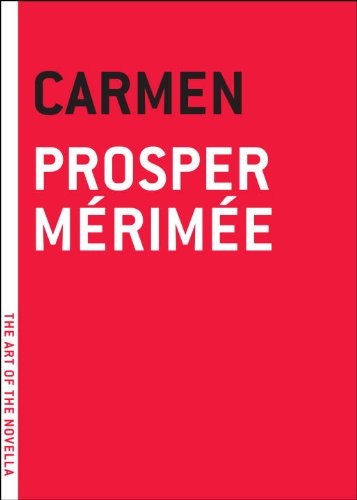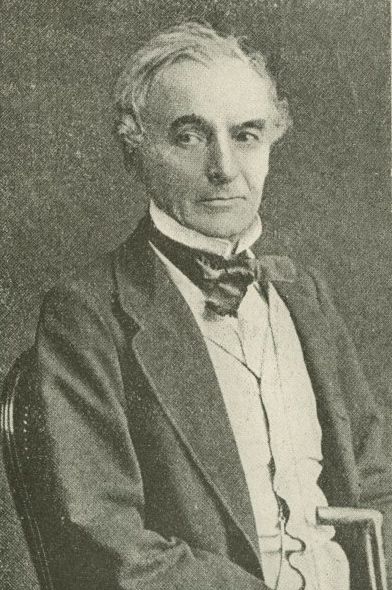
photo © Magdalena Roeseler, 2013
by Mike Smith
I hadn’t encountered Prosper Mérimée (1803-1870) before reading a handful of his stories in The World’s Thousand Best Short Stories, published in 1933. Opera buffs might know him as the originator of the story Carmen. Others may have seen his stories in The Twelve Best Short Stories in the French Language from 1920, or the Folio Society’s 1998 Book of French Short Stories. The editor of the latter, Brian Masters, gives us some brief comments on Mérimée’s work:
[He] strove to ensure that his work was terse, clear, vivid and concise, shorn of verbosity. He was a master at shining light on a significant detail which he sought to illuminate, and one suspects the detail was the grain from which the story grew.
If this paints Mérimée as someone with whom those of us striving to write today can identify, then what Edward Wright (who provides the introduction to Volume III of the The World’s Thousand Best Short Stories) says will seem more of a point: ‘Mérimée is the creator of the modern conte.’
Conte, if you’re not of the academic persuasion, turns out to be the French word for ‘story’. The Penguin Dictionary of Literary Terms gives ‘tales, story’, and points out that Guy de Maupassant referred to his short stories as contes. Brian Masters gives us a quotation from Mérimée: ‘Je n’aime dans l’histoire que les anecdotes.’ Cast into good northern English, this would be something like: ‘I like nowt but anecdotes (lad).’ The Penguin Dictionary also points out that the conte should be ‘a little fantastic’, which it then refines in parentheses to ‘not realistic’, before adding ‘droll and witty’. In practice, the accuracy of this, I suspect, hangs on the word ‘little’ and the reminder that reality often can be stranger than fiction.
Mérimée’s seven stories that are collected in The World’s Thousand Best Short Stories, at first, seemed a disparate grouping. I wondered, is there a Prosper Mérimée stamp upon them? Is there the common hallmark of the short story, whatever that might be?
In ‘Mateo Falcone’, as Professor Charles E. May points out in the opening chapter of The Short Story: The Reality of Artifice, Mérimée takes a folktale-like story, but makes it grimly real. Set in Corsica, it recounts a short series of events, in which the eponymous father kills his clever, but covetous, ten-year-old son for betraying a fugitive to his pursuers. The story has an  interesting and distinct structure, for it falls into two parts, each itself divided. Firstly, the scene is set, in landscape and in society. Notably, we learn of the Maquis, a shrub-land where fugitives are safe by virtue of its close growth and abundant food on the hoof (and the support of local shepherds): ‘The maquis is the home of the Corsican peasant and of whoever is in trouble with the police.’
interesting and distinct structure, for it falls into two parts, each itself divided. Firstly, the scene is set, in landscape and in society. Notably, we learn of the Maquis, a shrub-land where fugitives are safe by virtue of its close growth and abundant food on the hoof (and the support of local shepherds): ‘The maquis is the home of the Corsican peasant and of whoever is in trouble with the police.’
It is a creation of lazy farmers, who burn off the top-growth of trees to make a fertile ash in which to grow their crops, leaving the roots to sprout ever more thickly afterwards. Both real, and metaphorical, this landscape enables and mirrors what is happening in the human story.
While his mother and father (Mateo) are away hunting in the Maquis, Fortunato encounters the fugitive, out of whom he negotiates five francs for hiding him. Moments later he equally boldly negotiates a pocket watch out of the pursuing soldiers, for betraying where he has hidden the bandit. First, the fugitive is outfaced by Fortunato:
“Come, hide me, or I’ll kill you.”
“Your gun is not loaded, and there are no cartridges in your bandolier.”
Next, the adjutant gets equally short shrift:
“…haven’t you seen a man go by?”
“Have I seen a man go by?”
“Yes; a man with a pointed cap and a waistcoat worked in red and yellow.”
“A man with a pointed cap and a waistcoat worked in red and yellow?”
Then Mateo and his wife return. In contrast to the insolent, precocious bantering of Fortunato comes a far more tense and threatening tone between Mateo and the leader of the soldiers. The soldier reveals what Fortunato has done and, after the soldier has gone, Mateo leads the boy off into the wilderness. Implacable in his determination, Mateo resists his son’s pleas, makes him say his prayers, and then shoots him. The story is brutal, short and uncompromising, as is its setting.
If this is the beginning of the modern conte, then is it also a benchmark for the other stories of Mérimée? ‘The Etruscan Vase’ seems quite different, telling of a love affair troubled by the jealousy of the main protagonist. The character Saint-Clair is a nineteenth century equivalent of a stereotypical ‘lad’. Well heeled, and one of a louche group of male friends who rib each other and indulge in what we would now think of as sexist banter, Saint-Clair’s feelings are focussed on the eponymous crock, given to the lady in the piece by a previous lover. Or so he thinks. Her apparent love for the vase, he believes, reflects her love for the other man. Irked by his feelings, Saint-Clair reacts angrily to the taunts of the friend who has told him about the lover in the first place, and a dual is proposed. Then Saint-Clair, confronting the woman, discovers that the other man had not been taken seriously and is, in fact, considered a joke. She reads out a love letter from Massigny ‘amid bursts of laughter!’
Suddenly, Saint-Clair sees his error.
“I am a wretch… They told me you had loved Massigny, and–”
“Massigny!” and she began to laugh.
The vase is smashed to prove it. Saint-Clair is overjoyed and plans to apologise to his friend, but first, gallantly, he will let him have the first shot. Of course, the first shot turns out to be fatal and the two stories, despite their widely different settings and tones, come to a similar, brutal end.
Looking more closely we see again that use of the setting: the physical and the social, enabling and creating the possibility of the story taking place. The actual ending is not the shooting of Saint-Clair, but a discussion about it, and the recounting of the dual, by two of the other ‘lads’. After that, a further paragraph tells what has happened to the Countess, who has pined to death for loss of her lover.
These two stories have that heightened sense of tragedy that Romance demands. Not only is the loss irrevocable but also it is entirely unnecessary, except by the choices that the people, in those places, at those times, in the physical and social settings in which they existed, felt that they had to make.
‘Tamango’ is a much more difficult story for a twenty-first century reader to tackle, for it deals with the slave trade, and not explicitly in condemnation of it. Briefly, Tamango is a native slaver, who is captured along with the slaves he is selling, but who leads a rebellion on board ship. The crew is slaughtered, but the ship is beyond the technical knowledge of the freed slaves. They drift and die, finding the on-board alcohol, debauching and fighting while the unmanned ship disintegrates around them. Finally, only Tamango is left to be rescued by a British frigate. Taken to the West Indies, he recovers his health and, because he has only acted in self-defence (and killed only Frenchmen, not British), he is given a sinecure of six sous a day, plus  food. Eventually, he becomes the cymbal-player of a regimental band. But he drinks ‘rum and grog in inordinate quantities, and dies ‘in hospital of inflammation of the lungs’. Again, setting, combined with social mores, creates the story, and for three out of three, we end with death.
food. Eventually, he becomes the cymbal-player of a regimental band. But he drinks ‘rum and grog in inordinate quantities, and dies ‘in hospital of inflammation of the lungs’. Again, setting, combined with social mores, creates the story, and for three out of three, we end with death.
Two more of the stories go the same way. In ‘The Game of Backgammon’ a penitent gambler, who believes he has lost his reputation by cheating at Backgammon, persuades a shipmate to kill him, if battle does not! But the story is a framed story, being told to a passenger by the captain of a whaler, and at the moment when the friend must perform his duty, a whale is spotted and the captain breaks off his narrative. We are left to speculate, not if the protagonist dies, but how, which, of course, raises the sort of speculation we have been confronted with before. Again, it is a function of physical and social setting. In ‘The Taking of the Redoubt’ the same is true. A colonel’s last words confirm the soldierly bombast that a young subaltern, pushed up through the ranks as his superiors are killed, has struggled to find in himself.
‘The Venus of Ille’ has a death too, that of the old man who invites the narrator to his rural village to see the eponymous statue. It is an ancient bronze and seems to have a malevolent power: a worker is crushed by it; a boy throwing stones is hit by the ricochet; more frighteningly, the new son-in-law of the old man, on his wedding night, is killed by the statue, and the daughter driven insane by seeing the crime. Nobody, of course believes her, but we do. The narrator is telling of long past events, including the death of the old man, which follows a few years after, but he ends his story with a P.S. The statue has been melted down, and cast into bells for the local church: ‘Since this bell began to ring at Ille the vines have twice been frosted.’ Look at the syntax of that closing sentence – ‘frosted twice’ would be a much more natural expression, but the meaning of the sentence and the true end to the story have been manipulated into the very last word, ‘frosted’. The split infinitive has earned its keep.
This story can be found in The Twelve Best Short Stories in the French Language anthology. Written, or at least first published in 1837, this placing in the ‘Twelve Best’ makes a very serious claim for for the story, especially in 1920 when there is almost another hundred years to pick from. Of the seven stories I have looked at, it is, in several respects, the best. It has the element of outright magic, which the others do not, and, in having that magic, it has broken the recurrent train of setting, up to a point.
The narrator here is a Parisian, his host a countryman, though ‘a very learned antiquary’. Much is made of that difference, mostly by M. Puygarrig, the host. By placing the visit on the days of a country wedding, where the social backwardness of the country folk can be revealed, Mérimée has increased our awareness of the difference. There is, too, a party of Aragonese shepherds present, against whom the son-in-law to be plays tennis, and one of whom he insults. They are country people as well and atavistic in some degree. The wedding allows highlights of this divide, providing discussion of ring giving habits – contrasting the Parisian sophistication of the simple band with rural ostentation.
The wedding ring gets placed on the finger of the statue during the tennis game and cannot be removed for the ceremony. This is a further development of the malevolence attributed to the statue, yet still within the bounds of possibility. That final murder, though, is quite out of bounds, but, then again, it is only recounted by the maddened, widowed daughter. The Parisian narrator, by confessing his almost belief, encourages ours. He can find no other explanation. So setting and belief are again crucial to the story, linking it once more with the others.
Which leaves ‘The Blue Room’. If I tell you that this story ends with the sentence ‘Prepare a really good lunch for us at twelve’, you might expect a lighter tone and a happier story, and you would be right to do so. A couple fleeing from their situations stay a night in a hotel, under assumed names. They endure the noisy, rude banter of some soldiers in another room and encounter an Englishman with a seemingly unsavoury cousin. Eventually, they get what they have come for: the tranquility and passion of each other’s company. But when the man wakes in the night he hears a bump next door, where the Englishman sleeps, and thinks he hears soft footsteps retreating. He sees a dark, red liquid oozing under the rooms’ connecting door.
Murder has obviously been done and the couple are witnesses, perhaps even suspects! They are there under a false name, after all. They must flee and are preparing to do so when – as the eagle eyed reader might have guessed, for there is a clue – the truth is revealed: there has been no murder and there will be no enquiry, nor pursuit, which leads to that last line about lunch.
And here, in this light and humorous piece, which typifies for me a style of French stories that I found in Bonaventure des Périers’ fourteenth century ‘The Cobbler Blondeau’, we have the same necessity of setting, physical and social, to enable and create the events. Once again we are led towards death, and death by murder, and the trapping of the innocent in a snare they have laid for themselves. But here it is all a trick, a trick played on us by the author, unless we have caught his sleight of hand.
In Florence Goyet’s The Classic Short Story, much is made of the short story being about situation rather than character. Though they come from a time before the period this book examines, I think all of these stories fully endorse that view. It is a hallmark of the genre.
